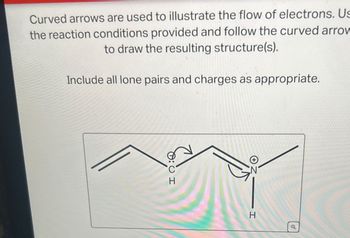
Pushing Electrons
4th Edition
ISBN: 9781133951889
Author: Weeks, Daniel P.
Publisher: Cengage Learning
expand_more
expand_more
format_list_bulleted
Question

Transcribed Image Text:Curved arrows are used to illustrate the flow of electrons. Us
the reaction conditions provided and follow the curved arrow
to draw the resulting structure(s).
Include all lone pairs and charges as appropriate.
H
:I
H
0
Expert Solution
This question has been solved!
Explore an expertly crafted, step-by-step solution for a thorough understanding of key concepts.
Step by stepSolved in 2 steps with 1 images

Knowledge Booster
Similar questions
- Write an equation to show the reaction between ethanol, C2H5OH and methyllithium, CH3 Draw all non-bonding electrons and show electron flow with curved arrows.arrow_forwardWrite an equation for the reaction of CH3 SCH3 with BF3, a Lewis acid, and show by the use of curved arrows how the reaction occurs. • Show all hydrogen atoms that are not attached to a carbon atom. Apply formal charges where appropriate. Assign lone pairs and radical electrons where appropriate. • Use the "starting points" menu to revert to the original molecule(s) shown. • Draw the appropriate electron-flow arrows. • Omit+ signs between structures. ● ● CH3 | :S: | CH3 == starting points == ↑ TAYY : F کر ? ChemDoodleⓇarrow_forwardExperimentally, the shape around the highlighted nitrogens is found to be trigonal planar rather than trigonal pyramidal predicted by the Lewis structure above. Sketch a resonance structure that would account for trigonal planar geometry about the highlighted nitrogens in uracil. Add formal charges to the four atoms that have non-zero formal charges. LA O--arrow_forward
- Please answer all parts. Thanks!arrow_forwardGive the TUP AC name of the compoundarrow_forwardHow many electron pairs are shared when a triple bond exists between two carbon atoms? What must he the geometric arrangement around the carbon atoms in a triple bond? Draw the Lewis structure of a simple molecule that contains a triple bond.arrow_forward
- Ethanol, , is a compound in which the formal charge on all the atoms is zero. Under certain conditions the bond can be broken so that both electrons remain with the oxygen atom. The products are In this structure the oxygen owns one electron from shared pair and two electrons from each of unshared pairs. The total number of electrons belonging to oxygen is Oxygen is a Group element. The formal charge on the oxygen atom is . The correct Lewis structure for the ethoxide ion is Note that the other fragment, the proton, leaves with a formal charge of +1.arrow_forwardYou will not find “hydroxide” in the stockroom, but you will find sodium hydroxide (NaOH) andpotassium hydroxide (KOH). Lithium hydroxide (LiOH) is expensive and used in spacecraft airfilters since hydroxide reacts with carbon dioxide, and lithium is lighter than sodium or potassium.Cesium and francium hydroxides are very expensive and little used. Is this information consistentwith your answer to the previous question?arrow_forwardComplete the general acid reaction for the four acid halies (HX). Draw and upload the Lewis structures of the reactants and products for each reaction. HF + H₂O HCI + H₂O → HBr + H₂O → HI + H₂O → Each of these reactions should include: lone pairs of electrons, partial charges, and mechanistic arrows to show the movement of electrons.arrow_forward
- The curved arrow notation introduced in Section 1.6B is a powerful method used by organic chemists to show the movement of electrons not only in resonance structures, but also in chemical reactions.Because each curved arrow shows the movement of two electrons, following the curved arrows illustrates what bonds are broken and formed in a reaction. Consider the following three-step process. (a) Add curved arrows in Step [1] to show the movement of electrons. (b) Use the curved arrows drawn in Step [2] to identify the structure of X. X is converted in Step [3] to phenol and HCl.arrow_forwardNonearrow_forwardPlease explain. I’m very confused on what to do. I know it has to deal with arrowsarrow_forward
arrow_back_ios
SEE MORE QUESTIONS
arrow_forward_ios
Recommended textbooks for you

 Living By Chemistry: First Edition TextbookChemistryISBN:9781559539418Author:Angelica StacyPublisher:MAC HIGHERChemistry: Matter and ChangeChemistryISBN:9780078746376Author:Dinah Zike, Laurel Dingrando, Nicholas Hainen, Cheryl WistromPublisher:Glencoe/McGraw-Hill School Pub Co
Living By Chemistry: First Edition TextbookChemistryISBN:9781559539418Author:Angelica StacyPublisher:MAC HIGHERChemistry: Matter and ChangeChemistryISBN:9780078746376Author:Dinah Zike, Laurel Dingrando, Nicholas Hainen, Cheryl WistromPublisher:Glencoe/McGraw-Hill School Pub Co Introductory Chemistry: A FoundationChemistryISBN:9781337399425Author:Steven S. Zumdahl, Donald J. DeCostePublisher:Cengage Learning
Introductory Chemistry: A FoundationChemistryISBN:9781337399425Author:Steven S. Zumdahl, Donald J. DeCostePublisher:Cengage Learning
 Organic Chemistry: A Guided InquiryChemistryISBN:9780618974122Author:Andrei StraumanisPublisher:Cengage Learning
Organic Chemistry: A Guided InquiryChemistryISBN:9780618974122Author:Andrei StraumanisPublisher:Cengage Learning


Living By Chemistry: First Edition Textbook
Chemistry
ISBN:9781559539418
Author:Angelica Stacy
Publisher:MAC HIGHER

Chemistry: Matter and Change
Chemistry
ISBN:9780078746376
Author:Dinah Zike, Laurel Dingrando, Nicholas Hainen, Cheryl Wistrom
Publisher:Glencoe/McGraw-Hill School Pub Co

Introductory Chemistry: A Foundation
Chemistry
ISBN:9781337399425
Author:Steven S. Zumdahl, Donald J. DeCoste
Publisher:Cengage Learning


Organic Chemistry: A Guided Inquiry
Chemistry
ISBN:9780618974122
Author:Andrei Straumanis
Publisher:Cengage Learning